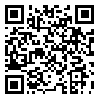Volume 17, Issue 2 (Vol 17,No.2, Summer 2021 2021)
irje 2021, 17(2): 116-124 |
Back to browse issues page
Download citation:
BibTeX | RIS | EndNote | Medlars | ProCite | Reference Manager | RefWorks
Send citation to:



BibTeX | RIS | EndNote | Medlars | ProCite | Reference Manager | RefWorks
Send citation to:
Derik M A, Kakavand M, Mamdohi S, Navabi M, Goodarzi E, Mokhayeri H et al . Evaluation of Hepatitis A Outbreak in Boroujerd during 2019: A Case-Control Study. irje 2021; 17 (2) :116-124
URL: http://irje.tums.ac.ir/article-1-6990-en.html
URL: http://irje.tums.ac.ir/article-1-6990-en.html
Mohammad Ali Derik1 
 , Mohammad Kakavand2
, Mohammad Kakavand2 
 , Shahram Mamdohi3
, Shahram Mamdohi3 
 , Mojgan Navabi4
, Mojgan Navabi4 
 , Elham Goodarzi5
, Elham Goodarzi5 
 , Hamid Mokhayeri6
, Hamid Mokhayeri6 
 , Zaher Khazaei *
, Zaher Khazaei * 
 7
7

 , Mohammad Kakavand2
, Mohammad Kakavand2 
 , Shahram Mamdohi3
, Shahram Mamdohi3 
 , Mojgan Navabi4
, Mojgan Navabi4 
 , Elham Goodarzi5
, Elham Goodarzi5 
 , Hamid Mokhayeri6
, Hamid Mokhayeri6 
 , Zaher Khazaei *
, Zaher Khazaei * 
 7
7
1- General Physician, Department of Health, Department of Prevention and Control of Infectious Diseases, Lorestan University of Medical Sciences, Khorramabad, Iran
2- General Surgery, Boroujerd Health Network, Boroujerd, Iran
3- General Physician, Boroujerd Health Network, Boroujerd, Iran
4- Disease Control Expert, Boroujerd Health Network, Boroujerd, Iran
5- MSc of Epidemiology, Social Determinants of Health Research Center, Lorestan University of Medical Sciences, Khorramabad, Iran
6- Public Health Expert, Department of Prevention and Control of Infectious Diseases, Lorestan University of Medical Sciences, Khorramabad, Iran
7- MSc of Eidemiology, Nahavand Paramedical Faculty, Hamadan University of Medical Sciences, Hamadan, Iran ,Zaherkhazaei@yahoo.com
2- General Surgery, Boroujerd Health Network, Boroujerd, Iran
3- General Physician, Boroujerd Health Network, Boroujerd, Iran
4- Disease Control Expert, Boroujerd Health Network, Boroujerd, Iran
5- MSc of Epidemiology, Social Determinants of Health Research Center, Lorestan University of Medical Sciences, Khorramabad, Iran
6- Public Health Expert, Department of Prevention and Control of Infectious Diseases, Lorestan University of Medical Sciences, Khorramabad, Iran
7- MSc of Eidemiology, Nahavand Paramedical Faculty, Hamadan University of Medical Sciences, Hamadan, Iran ,
Abstract: (1517 Views)
Background and Objectives: Viral hepatitis is one of the most prevalent diseases and an important underlying cause of death and disability in the world. This case-control study was conducted to investigate the outbreak of hepatitis A in Boroujerd in 2019.
Methods: This case-control study was conducted to investigate the epidemic of hepatitis A in Boroujerd in 2019. Fifty hepatitis A patients were recruited. For each patient diagnosed, two controls with no history of the disease were selected from a neighboring village. Data were collected using a demographic questionnaire as well as the results of experiments. To investigate the association between the disease and risk factors, odds ratio and 95% confidence interval were used.
Results: In this study, the odds ratios were significant for a number of risk factors including washing fruits and vegetables with a source other than tap water [OR = 3.2], washing dishes with a source other than tap water [OR = 3.7], non-sanitary toilets [OR = 8.3], using sources other than tap water when there is no tap water [OR = 4.4], being unaware of the disease and its transmission methods [OR = 4.8] and water well dug less than 15 m from the sewage well (OR = 4.1).
Conclusion: Increased public awareness and improved health status of the environment and rural sewage can preclude similar epidemics in the study area and other regions.
Methods: This case-control study was conducted to investigate the epidemic of hepatitis A in Boroujerd in 2019. Fifty hepatitis A patients were recruited. For each patient diagnosed, two controls with no history of the disease were selected from a neighboring village. Data were collected using a demographic questionnaire as well as the results of experiments. To investigate the association between the disease and risk factors, odds ratio and 95% confidence interval were used.
Results: In this study, the odds ratios were significant for a number of risk factors including washing fruits and vegetables with a source other than tap water [OR = 3.2], washing dishes with a source other than tap water [OR = 3.7], non-sanitary toilets [OR = 8.3], using sources other than tap water when there is no tap water [OR = 4.4], being unaware of the disease and its transmission methods [OR = 4.8] and water well dug less than 15 m from the sewage well (OR = 4.1).
Conclusion: Increased public awareness and improved health status of the environment and rural sewage can preclude similar epidemics in the study area and other regions.
Type of Study: Research |
Subject:
Epidemiology
Received: 2021/11/23 | Accepted: 2021/09/21 | Published: 2021/09/21
Received: 2021/11/23 | Accepted: 2021/09/21 | Published: 2021/09/21
Send email to the article author
| Rights and permissions | |
 |
This work is licensed under a Creative Commons Attribution-NonCommercial 4.0 International License. |



